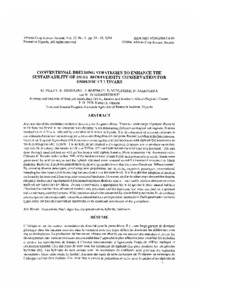| dc.contributor.author | Pillay, M. |
| dc.contributor.author | Ssebuliba, R. |
| dc.contributor.author | Hartman, J. |
| dc.contributor.author | Vuylsteke, D. |
| dc.contributor.author | Talengera, D. |
| dc.contributor.author | Tushemereirwe, W.K. |
| dc.date.accessioned | 2019-12-04T11:23:35Z |
| dc.date.available | 2019-12-04T11:23:35Z |
| dc.date.issued | 2004 |
| dc.identifier.citation | Pillay, M., Ssebuliba, R., Hartman, J., Vuylsteke, D., Talengera, D. & Tushemereirwe, W. (2004). Conventional breeding strategies to enhance the sustainability of Musa biodiversity conservation for endemic cultivars. African Crop Science Journal, 12(1), 58-65. |
| dc.identifier.issn | 1021-9730 |
| dc.identifier.uri | https://hdl.handle.net/20.500.12478/4046 |
| dc.description.abstract | Africa is one of the secondary centers of diversity for the genus Musa. There is a wide range of genetic diversity in the bananas found in the continent with different types dominating different ecological sub-regions. Banana production in Africa is affected by a number of diseases and pests. The development of resistant cultivars is considered to be the most effective approach to controlling diseases and pests. Banana breeding at the International Institute of Tropical Agriculture (IITA) involves crossing triploid (3x) landraces with diploid (2x) accessions to produce tetraploid (4x) hybrids. The 4x hybrids are crossed with improved 2x accessions to produce secondary triploids. In this study, the female fertility of 70 East African highland banana landraces was assessed. This was done through hand pollination with pollen from a wild diploid banana, Musa acuminata spp. burmannicoides Calcutta 4'. Results indicate that 50% of the landraces were female fertile and produced true seeds. Seeds were germinated by embryo rescue and the hybrids obtained were assessed to exhibit increased resistance to black sigatoka. However, bunch weights of the hybrids were generally lower than the control landrace, ‘Mbwazirume'. By crossing diverse genotypes, producing new populations and selecting improved genotypes, conventional breeding has the potential of increasing banana diversity at the farm level. It is thought that adoption of modern cultivars by farmers could lead to genetic erosion of landraces. However, studies in other crops showed that despite adopting modern cultivars farmers still maintain landraces. Both Ex-situ (off-site) and In-situ (on-site) conservation methods are important for Musa. In-situ conservation is appropriate for wild species in their natural habitats allowing the continuation of natural evolutionary processes and for landraces that were selected for important traits over many years by farmers. Wild species could also be conserved Ex-situ in field gene banks, In vitro culture and cryopreservation especially where their natural habitats are in prone to destruction. Field gene banks are more appropriate for breeders providing opportunities for continual assessment of the germplasm. |
| dc.language.iso | en |
| dc.subject | Bananas |
| dc.subject | Musa |
| dc.subject | Cryopreservation |
| dc.subject | Hybrids |
| dc.subject | Land Races |
| dc.subject | Plant Diseases |
| dc.title | Conventional breeding strategies to enhance the sustainability of Musa biodiversity conservation for endemic cultivars on farm |
| dc.type | Journal Article |
| dc.description.version | Peer Review |
| cg.contributor.crp | Roots, Tubers and Bananas |
| cg.contributor.affiliation | International Institute of Tropical Agriculture |
| cg.contributor.affiliation | Kawanda Agricultural Research Institute, Uganda |
| cg.coverage.region | Africa |
| cg.coverage.region | East Africa |
| cg.coverage.country | Uganda |
| cg.authorship.types | CGIAR and developing country institute |
| cg.iitasubject | Banana |
| cg.iitasubject | Plant Breeding |
| cg.accessibilitystatus | Limited Access |
| local.dspaceid | 99332 |
| cg.identifier.doi | https://doi.org/10.4314/acsj.v12i1.27663 |

